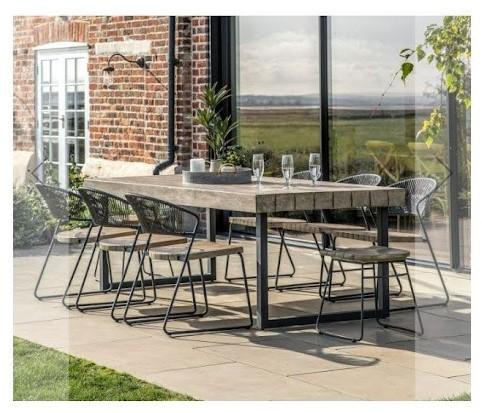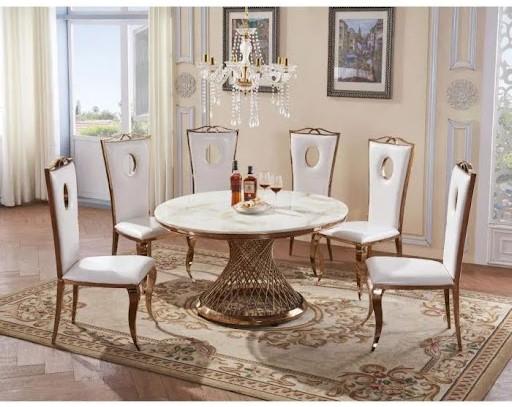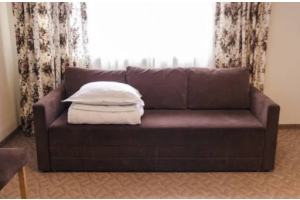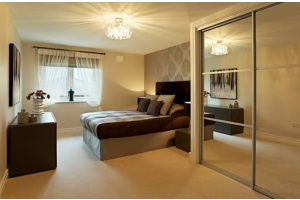
The perfect dining room table is essential for creating a welcoming and functional space. It’s not just about aesthetics; the right table should comfortably accommodate the number of people you intend to host while seamlessly fitting into your room's dimensions. This guide will discuss the major types of dining tables helping you find the ideal size that suits both your space and your lifestyle. Whether you’re planning intimate family dinners or lively gatherings with friends, understanding these options will empower you to make the best choice for your home!
Things to Consider Before Finding the Dimensions of Your Table

First lets discuss the several key factors to consider to ensure a comfortable dining experience.
1. Space Per Diner
When planning for seating, it’s important to allocate enough space for each diner. A general guideline is to allow about 92 cm of space per person. For example, if you want four people to sit comfortably on the longer side of a rectangular table, the minimum length should be at least 92 cm multiplied by 4, which equals 368 cm. Additionally, for corner seats, you can use half of that measurement to account for the extra space needed. This will ensure everyone has enough room to eat and move comfortably.
2. Legroom
Legroom is another crucial consideration. To ensure comfortable seating, there should be at least 30 cm (approximately 12 inches) of clearance beneath the table. This space allows diners to sit without feeling cramped. Most dining tables on the market are typically between 28 to 30 inches (about 71 to 76 cm) high. This height works well with standard dining chairs heights, which usually range from 45 to 50 cm, ensuring that diners can sit comfortably without their knees hitting the table.
3. Spacing from Walls
Finally, consider the spacing of the table from walls and other furniture in the room. It's recommended to leave at least 92 cm of clearance on each side of the table. This distance not only allows for easy movement around the table but also provides space for pulling out chairs without obstruction. Adequate spacing enhances the flow of the dining area and contributes to a more inviting atmosphere.
How to Measure Dining Table Lengths
Here’s a more straightforward formula for calculating the ideal length of a dining table based on the dimensions of your dining room.
Formula for Table Length Based on Dining Room Dimensions
Table Length=Room Length−(2×Clearance Space)
Steps to Calculate:
- Measure the Room Length: Determine the total length of your dining room.
- Determine Clearance Space: Use at least 92 cm (about 36 inches) as the clearance space needed on each end of the table for comfortable movement.
- Apply the Formula: Subtract double the clearance space from the room length to find the maximum table length that will fit comfortably.
Example:
If your dining room is 400 cm long:
- Clearance Space: 92 cm
- Table Length Calculation:
Table Length=400 cm−(2×92 cm)\text{Table Length} = 400 \text{ cm} - (2 \times 92 \text{ cm}) Table Length=400 cm−(2×92 cm) Table Length=400 cm−184 cm=216 cm\text{Table Length} = 400 \text{ cm} - 184 \text{ cm} = 216 \text{ cm} Table Length=400 cm−184 cm=216 cm
This means the ideal length for your dining table would be up to 216 cm, allowing for ample space around it.
Rectangular Dining Tables Height
Rectangular dining tables are the most traditional style, often seen as the centerpiece of family gatherings and formal dining experiences. The versatility of rectangular tables is one of their greatest strengths. With their long sides and shorter ends makes them ideal for everything from casual family meals to elegant dinner parties. They can also be easily dressed up with elegant table settings for formal occasions or kept casual for family dinners. Their design versatility allows for various arrangements, whether placed against a wall for smaller spaces or centered in a room for larger gatherings.

For optimal comfort, the most common rectangular table sizes are designed to accommodate specific numbers of diners:
- 4-Seater: Typically around 120-150 cm in length, providing enough space for four people to sit comfortably, with at least 30 cm of space per person.
- 6-Seater: Usually measures between 150-180 cm long, allowing for three people on each longer side.
- 8-Seater: Generally ranges from 180-240 cm, making it spacious enough for four diners on each side.
If you plan to host larger gatherings, tables can extend, or you can opt for a larger size, ensuring you still provide at least 30 cm of space per person. For example, a table designed for 10 or more diners can be around 240-300 cm long, depending on the arrangement.
To complement rectangular tables, the chair’s height should fit well with the table’s height, which typically ranges from 71 to 76 cm (28 to 30 inches). Standard dining chairs with seat heights of 45 to 50 cm work perfectly, allowing for ample legroom and comfort. Upholstered chairs, wooden designs, or even modern metal options can all pair beautifully, depending on your decor style.
Circular Dining Tables Height
Circular dining tables are a wonderful choice for creating an inviting and intimate atmosphere in any dining space. Positioned at the center of a room, they foster conversation and connection, making them ideal for both family meals and social gatherings. The rounded edges allow everyone seated at the table to engage easily with one another. Here are the most common sizes:

- 4-Seater: Typically around 90-120 cm in diameter. This size comfortably fits four people while allowing for easy movement.
- 6-Seater: Generally measures between 120-150 cm in diameter. This size provides ample space for six diners, ensuring everyone has enough room to enjoy their meal.
- 8-Seater: Usually ranges from 150-180 cm in diameter. This larger size accommodates eight people, perfect for family gatherings or dinner parties.
If you plan to host more than eight guests, it’s advisable to consider using multiple tables or opting for a larger oval or rectangular option, as circular tables can become cramped when exceeding their intended capacity.
Circular tables design allows for flexibility in seating arrangements, making it easy to add or remove chairs as needed. This adaptability is particularly advantageous for events where guest lists may fluctuate, ensuring a comfortable dining experience for everyone.
How to Choose Your Dining Table Chairs?
Selecting the right dining room table is a crucial decision that can enhance both the functionality and aesthetics of your space. Here are three key factors to consider:
1. Dining Room Dimensions
Begin by measuring your dining room dimensions. A dining table should fit comfortably within the space, allowing for easy movement around it. Ideally, you should leave at least 92 cm of clearance on all sides for chairs and foot traffic. Consider the shape of the room as well; rectangular tables work well in long spaces, while round tables can soften corners and create a more intimate setting.
2. The Size of Your Family
Consider how many people you typically host when choosing your dining room table. If you often have family gatherings or entertain guests, selecting a table that meets your needs is essential. For a family of four, a table with a diameter of about 90-120 cm for round tables or 120-150 cm in length for rectangular tables is ideal. If you regularly seat six people, look for a round table around 120-150 cm in diameter or a rectangular table between 150-180 cm long. For eight diners, aim for a diameter of 150-180 cm for round tables or a length of 180-240 cm for rectangular options. If your family is larger or you frequently host more guests, consider extendable tables that can adjust to accommodate extra diners, ensuring everyone has a comfortable place at the table.
3. Dining Chairs You Opt For
Different chair styles can significantly impact your dining experience and the overall look of your dining area.For circular dining tables, bar stools can be a stylish option, especially for higher tables or informal dining setups. They add a modern touch and can easily be tucked away when not in use, freeing up space. Decorative dining chairs (mostly armless chairs) can also complement the soft curves of a circular table, creating a vibrant focal point in the room while armless versions facilitate easier movement and allow for a more open feel.
In contrast, rectangular dining tables lend themselves to a broader range of chair styles. For these tables, armed chairs can add a touch of elegance and comfort, particularly at the heads of the table, while armless chairs create a more streamlined look and maximize seating capacity along the longer sides. Overall armless chairs are always the best options for dining.
When selecting dining chairs, understanding the common heights and their corresponding table heights is essential for comfort and functionality. The most common seat height for dining chairs typically ranges from 45 to 50 cm (approximately 18 to 20 inches). For optimal comfort, the corresponding dining table height should be between 71 to 76 cm (about 28 to 30 inches).
The ideal distance between the seat of the chair and the underside of the table should be around 25 to 30 cm (10 to 12 inches). This space allows diners to sit comfortably without their knees bumping against the table, providing ample legroom for movement. Having this height difference is important as it ensures a pleasant dining experience, allowing for relaxed seating and easy access to food and drinks.





